Split, Croatia is a stop on many Mediterranean cruise itineraries. Located on the country’s Dalmatian coast, this was our first glimpse of Split from the ship during our cruise. With majestic mountains standing behind the coastal city, we couldn’t wait to see what it had to offer. See the things to do and how to spend the day in Split.
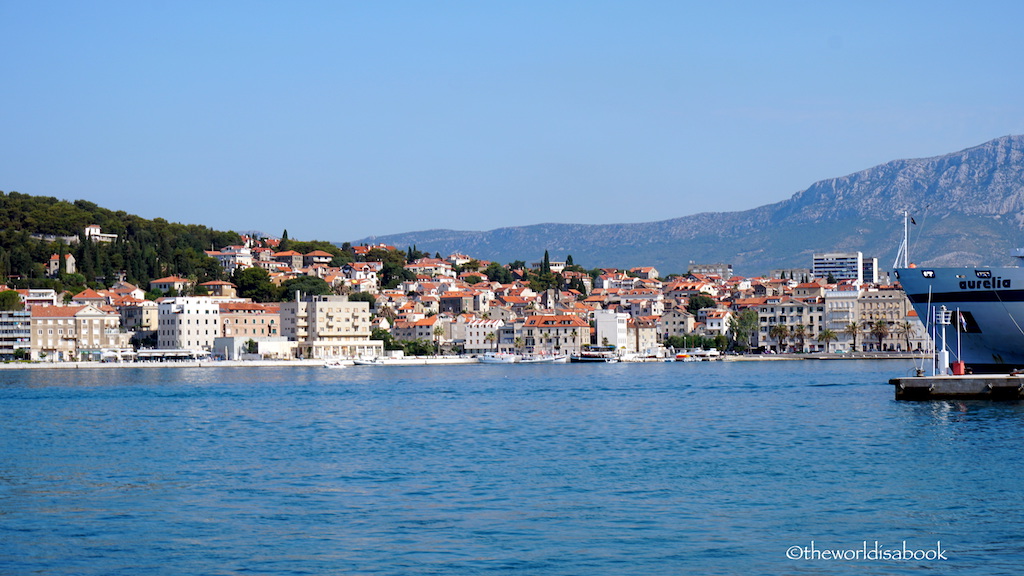
Split certainly has an unusual but also memorable name for us, English speakers. This is Croatia’s second largest city.
We purposely didn’t set up a shore excursion with the ship. From previous cruise experiences, we knew there were going to be many tour companies waiting for passengers outside the port gate. They’re also usually cheaper than the ones offered by the cruise ship.
It was a bit overwhelming to see all the tour guides and companies when we came out. We had an idea which tour we wanted to do already and went with the Grand Diocletian Tour which was a bus and walking tour combination.
The Grand Diocletian Tour
Our tour started with a quick drive around the city. We were glad that we actually had a tour guide talking to us instead of the pre-recorded commentary on headsets.
Her English was excellent. It was great to interact with her and ask her questions to learn more about the city.
We passed by parks and interesting buildings including the Poljud Stadium. They built this for the 1979 Mediterranean games. It looked so futuristic. Football (soccer for us, Americans) is huge here as expected.
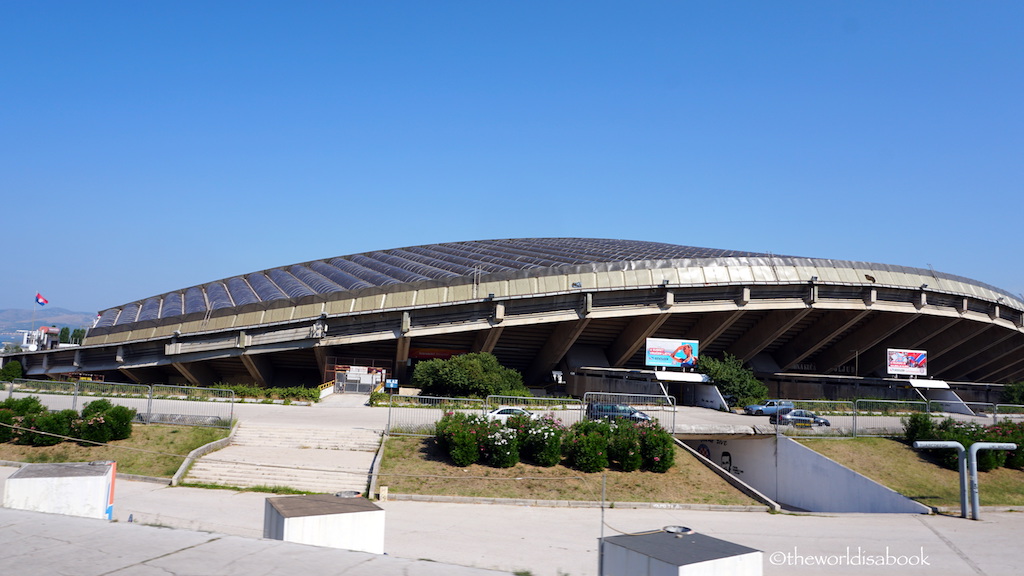
Marjan Forest Park, considered the “city’s lungs,” was one of the areas we would have loved to explore. It was such a contrast to the town and filled with many pine trees and vista points. Can you find the church that they built into the rock face?
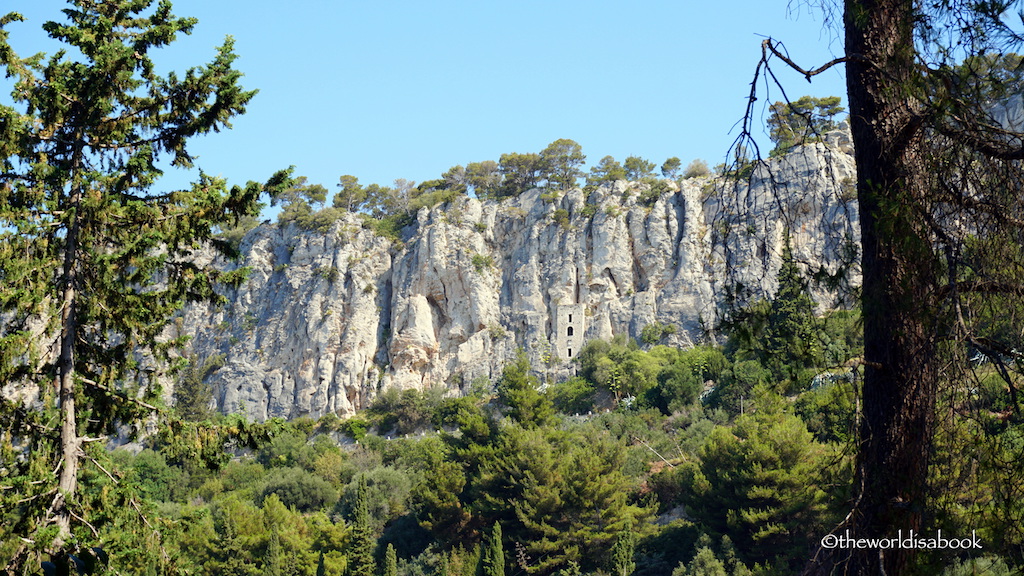
It was so hot so it was really great to be sightseeing through the bus. Though, it was almost torture to pass by the glistening waters off the coast and spot beaches like Bene and Zvoncac and we couldn’t take advantage of them.
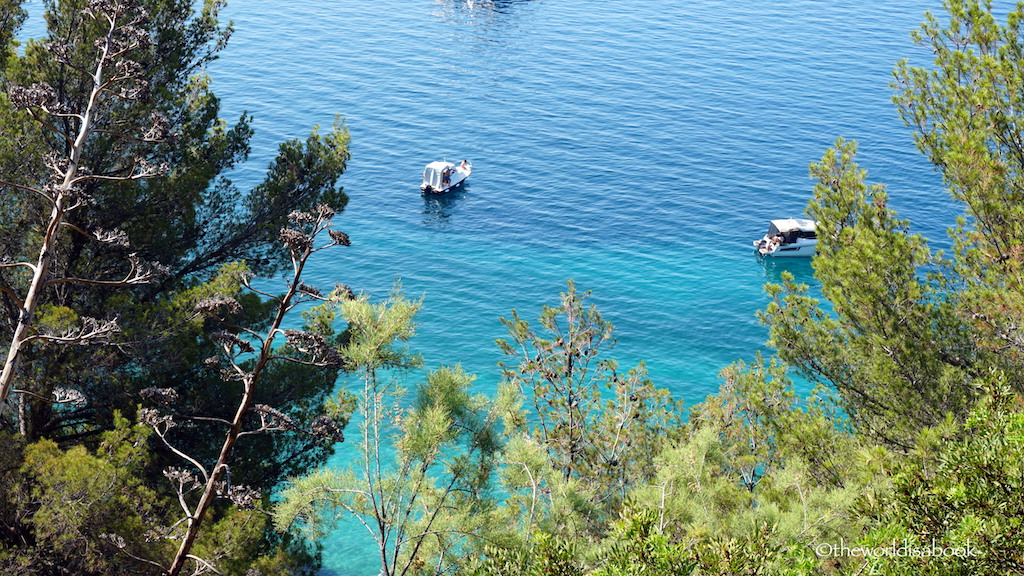
This tour was a wonderful opportunity to learn more about Split, the country and some of its famous people and customs. The city’s name is believed to have originated from a Greek colony that was once here, called Aspalathos. But, it is also related to yellow flowers found in the area with the same Greek name and called brnistra in Croatian.
The Italian version was Spalato. In the 19th century, it became Spljet and officially became Split in 1909. Unfortunately, as my son thought..banana split didn’t come from here.
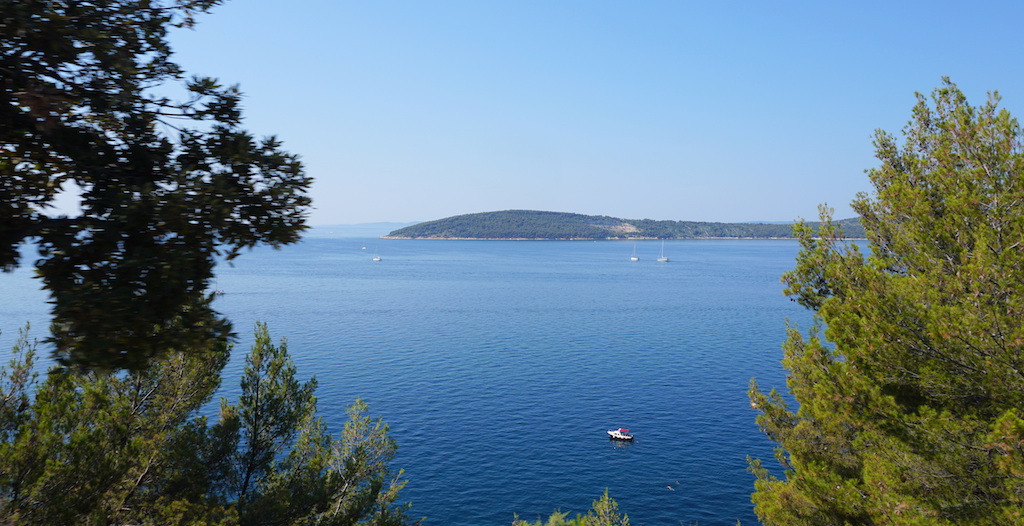
Walking tour of Diocletian’s Palace
Our bus tour ended near the port for the continuation of it via a walking tour of Diocletian’s Palace. This UNESCO World Heritage site is the city’s main attraction.
They designated it as the “best-preserved example of Roman palatial architecture.” We were so glad we were doing this tour with a guide because this complex was large and crowded.
The Roman Emperor Diocletian built this rectangular complex that covered seven acres during the 4th century. The imperial palace was the emperor’s retirement home and a military sea fortress.
Diocletian certainly knew how to retire in style. He made this palace mostly of Greek and Italian marble and white stone from the nearby island of Brac.
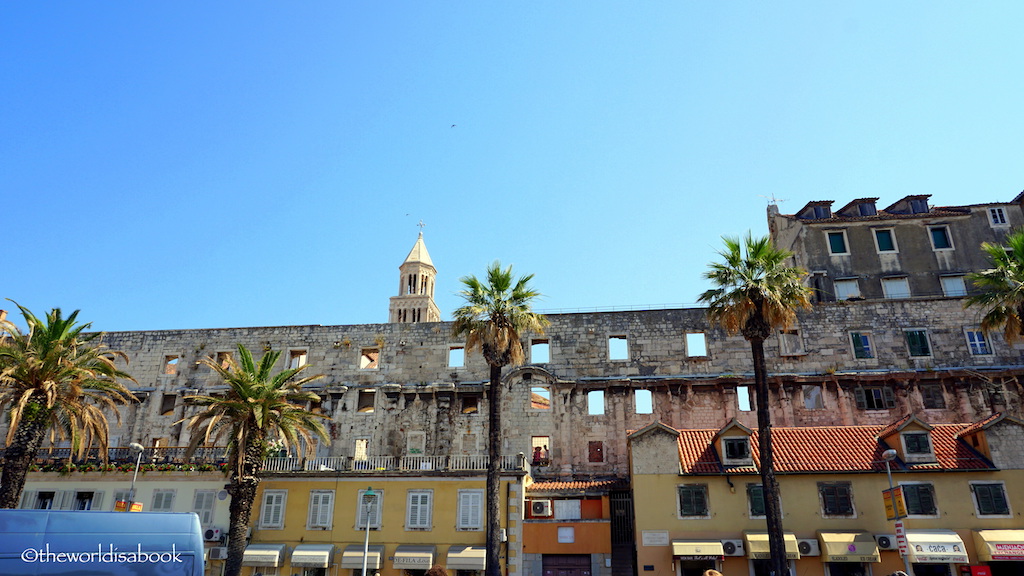
High walls, measuring 7 feet (2 m) surrounded the palace. The complex featured 16 towers, but only three remain.
Diocletian Palace Gates
The palace had four gates for the main entrances, named after metals: Bronze, Iron, Silver, and Golden. This was a photo of the palace during its glory days.
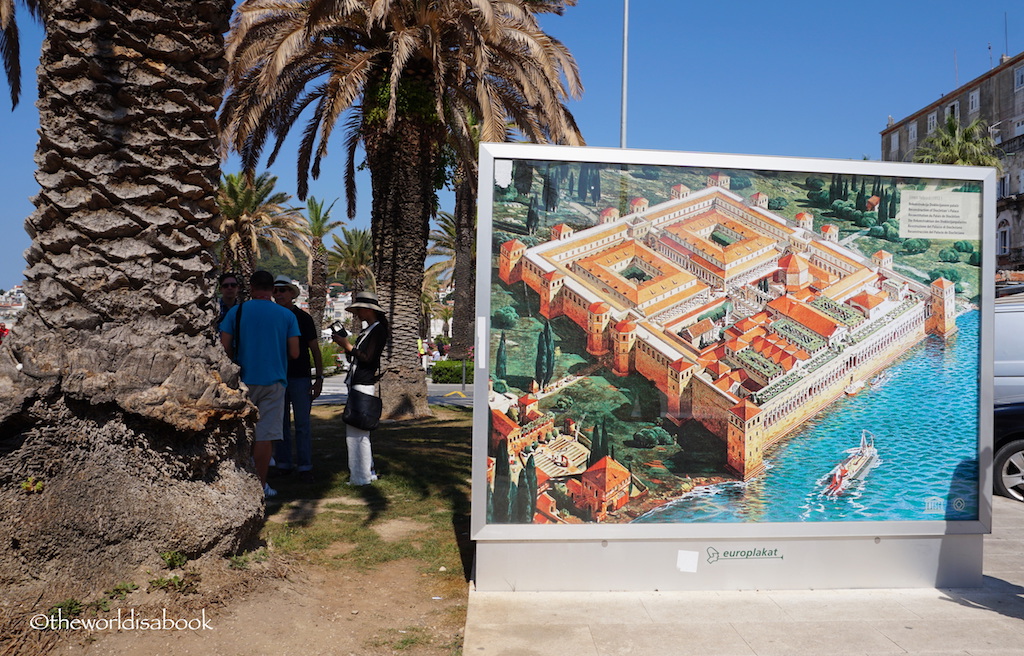
Our group entered the palace through the Bronze Gate into the palace’s old Central Hall basement. It was once used as a palace entrance if coming from the sea.
This area now features several souvenir, arts, and crafts shops. Other parts of the cellar were also used for art exhibitions and functions.
Peristil Square
We were then led to Peristil Square. This was the most crowded area and where many seem to like hanging out much like the old days.
Many historic sites surrounded this central court. We actually found some cushions and pillows for people to sit on a few of the steps provided by a restaurant nearby.
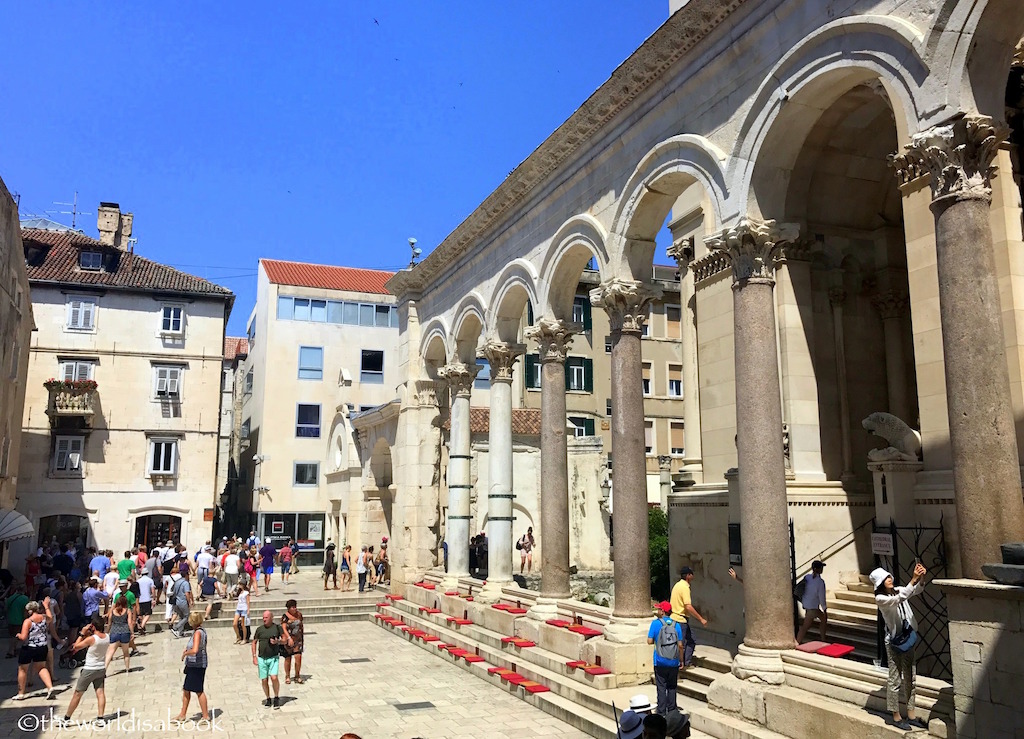
There were so many people here during our morning tour that it was hard to hear our guide or walk with our group. When we came back in the afternoon, it was a much more pleasant and relaxing experience with fewer tourists.
The Bell Tower
The most prominent structure in the palace complex is the bell tower of Katedral Sveti Duje or St. Duje (Domnius) Cathedral. They constructed this octagon-shaped cathedral during the 13th century using the site and materials from Diocletian’s mausoleum.
We passed on the experience to climb up the bell tower for a panoramic view of the town and the ocean. The line was long and it was too hot.
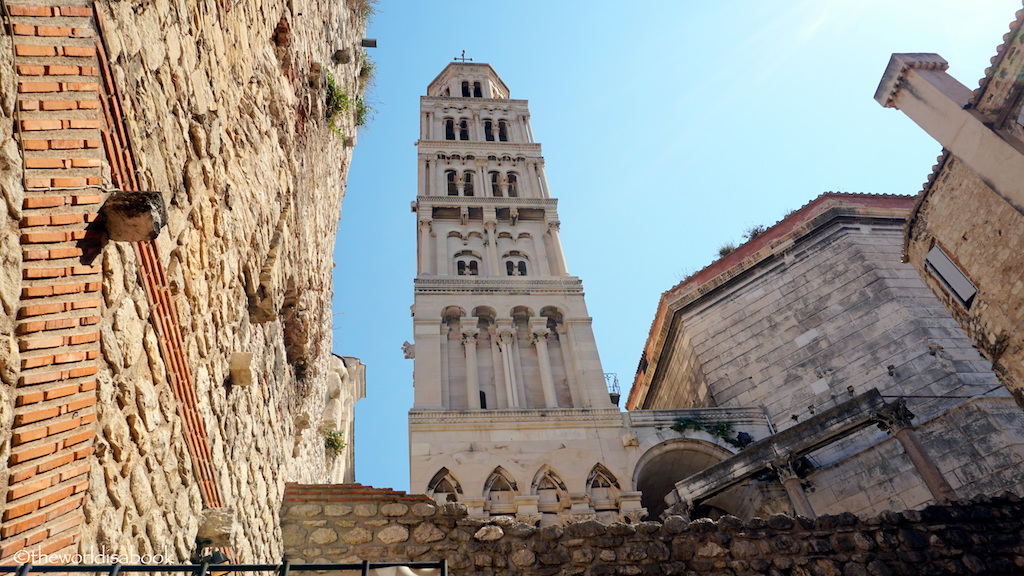
There was a granite and black sphinx that still stood outside the cathedral guarding it. This 1500 BC relic came from Luxor in ancient Egypt.
Emperor Diocletian was a fan of Egyptian items. He had over a dozen of these sphinxes but only three were still around.
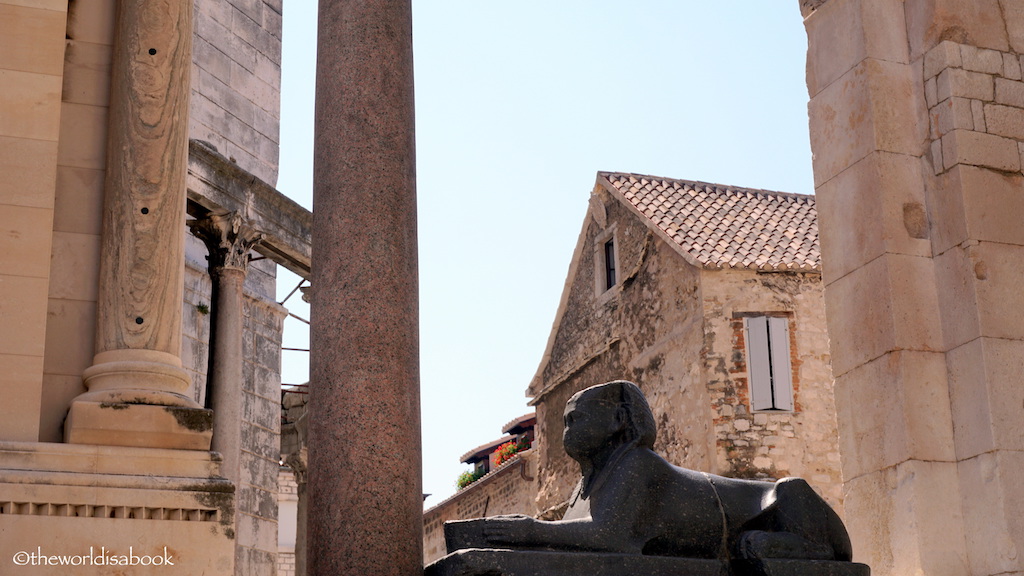
After Diocletian’s death, some expelled emperors and their families lived here. The town’s residents eventually moved into the palace’s walls and built settlements.
The palace complex became the old town itself. It is still a residence for some Split locals. There are over 200 buildings within the complex.
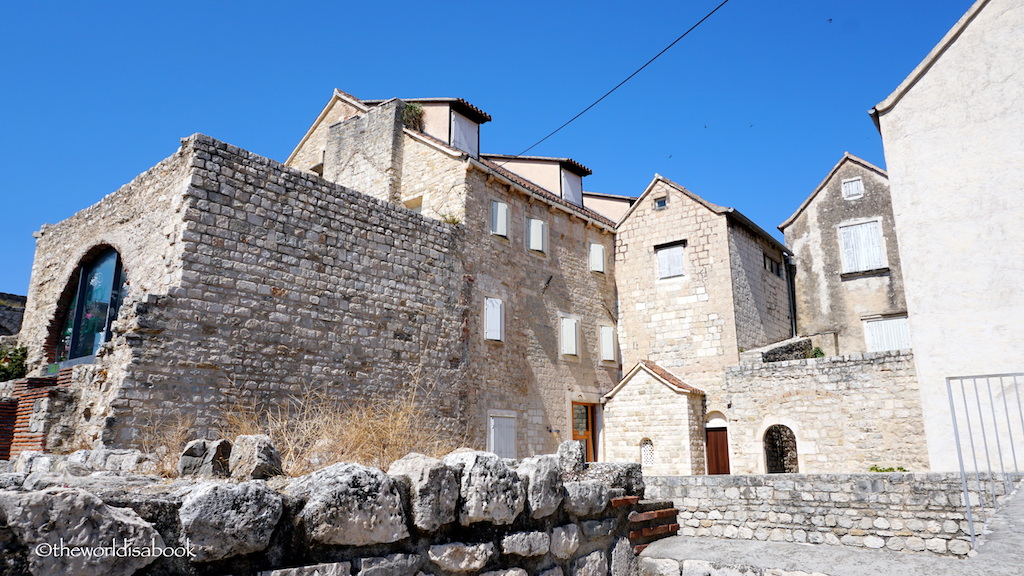
One of our favorite rooms was the Vestibule. This circular room once led to the the royal quarters. There used to be a cupola here but is now occupied by this large hole into the sky.
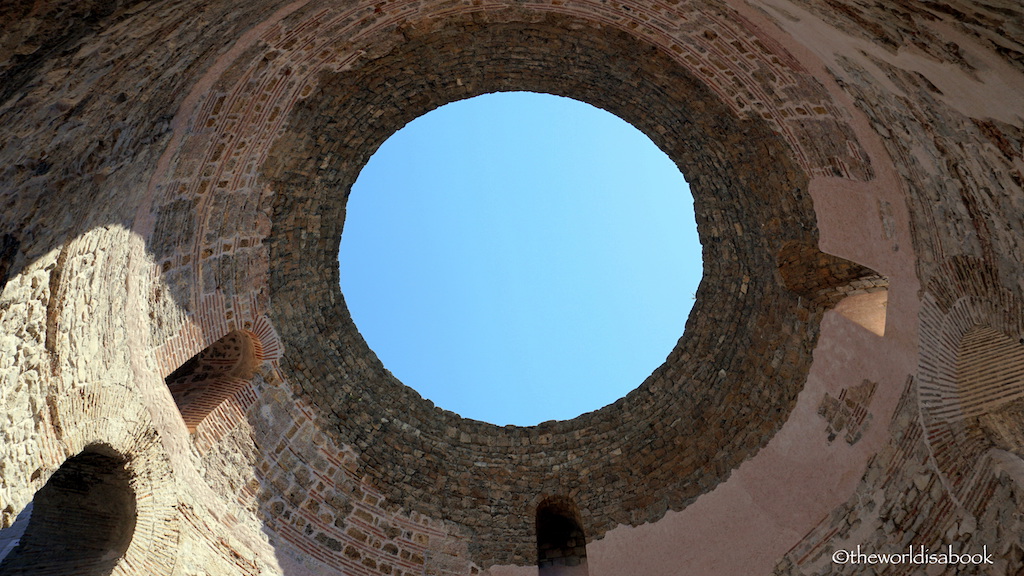
This space had such wonderful acoustics. We found a group of men here singing Acapella songs for the tourists. It was fantastic entertainment and such a great treat to hear.
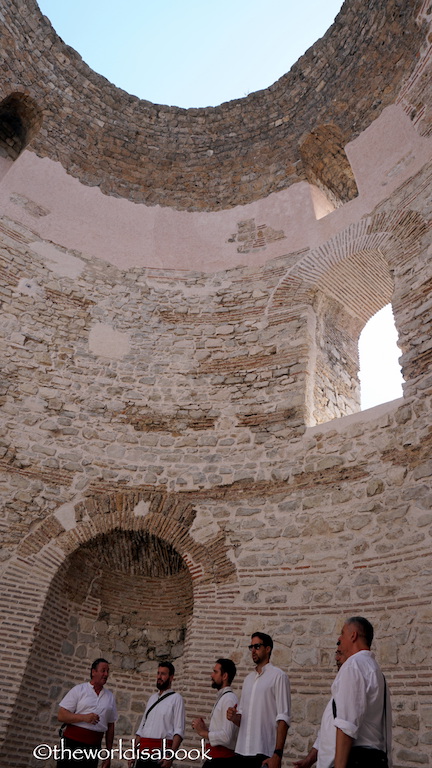
I loved seeing the architectural details as we walked through narrow alleys here. It was fun to imagine how this complex looked when it was first built and again during the Middle Ages when it became a mini-city. Though, it was still quite impressive.
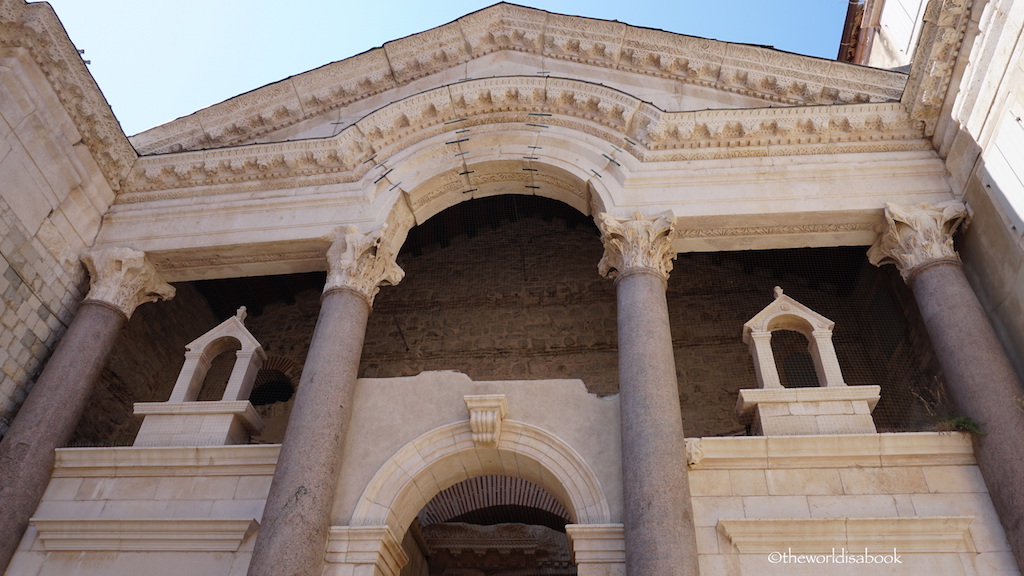
It was even more interesting to think that there were actual residents living within the walls of the ancient palace complex now. I loved how they incorporated modern living with all the ruins and old buildings.
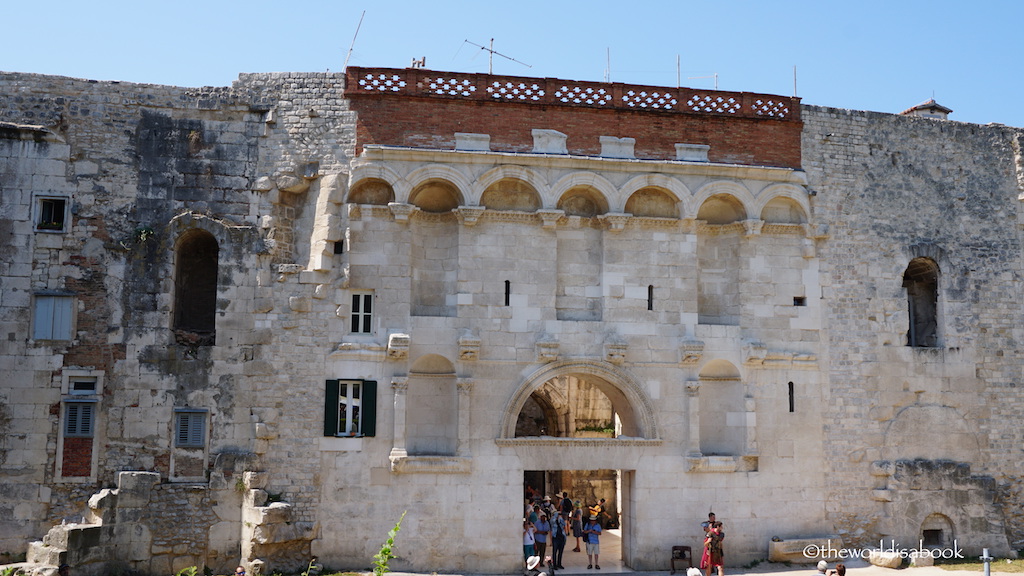
Gregory of Nin Statue
Exiting the Golden Gate, we encountered a very large bronze statue of an influential medieval bishop. Grgur Ninski or Gregory of Nin was regarded as a symbol of patriotism.
The statue was 28 ft (8.5 m tall) and impressive. Yet, its size isn’t why it’s popular but more for his toe.
Some believed that rubbing the statue’s big toe while wishing for something will fulfill that wish. We saw plenty of tourists rubbing the heck out of that toe. Of course, we did the same for some good luck and fortune.
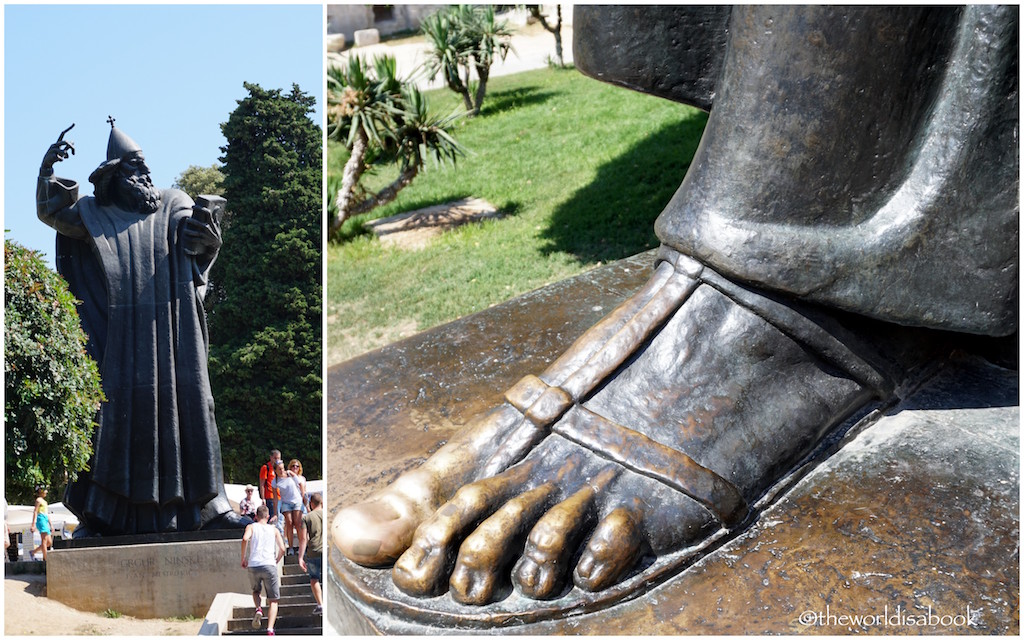
Fruit Square
Our walking tour ended on Fruit Square. This used to be a site of several fruit vendors. Nowadays, cafes and shops surround it.
The octagonal Venetian Tower was hard to miss here among the beautiful facades. This 15th century structure was a remnant of a former fortress.
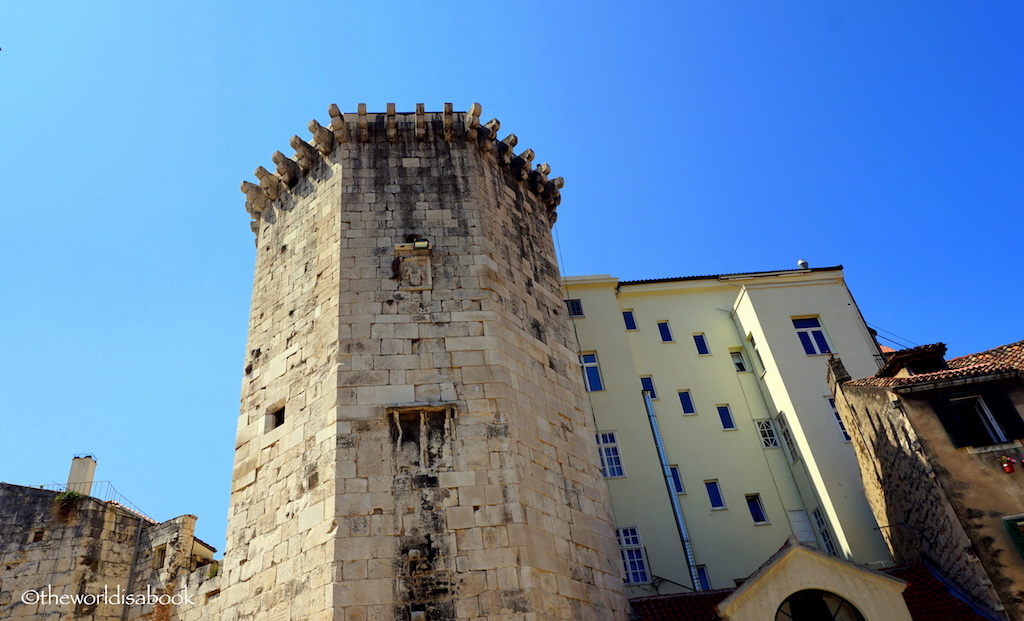
The Riva
Riva was another of Split’s main attraction along the waterfront area. This boardwalk had one side facing the ocean and backed by the ruins of the palace. It was a great place for a stroll and to enjoy the ocean view and sea breeze.
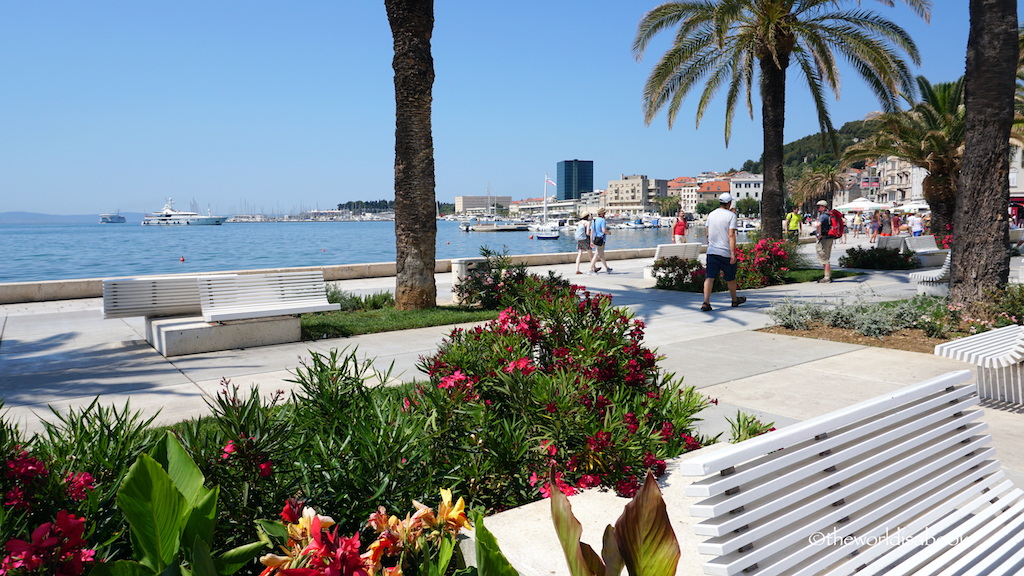
The public area featured benches, palm trees, planting beds, and numerous flowers. The Riva is 820 ft (250 m) long and 180 ft (55 m) wide.
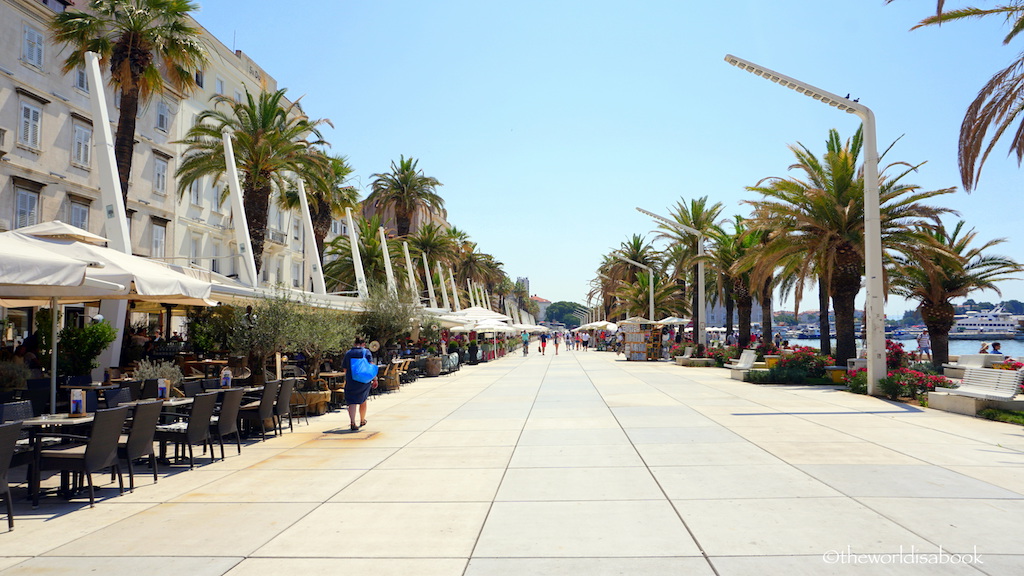
Over the years, its been the site of parades, rallies, festivals and endless get-togethers and meeting points for tourists and locals. Shops and open-air cafes also lined the area. If we were staying here longer, this would have been our hangout area.
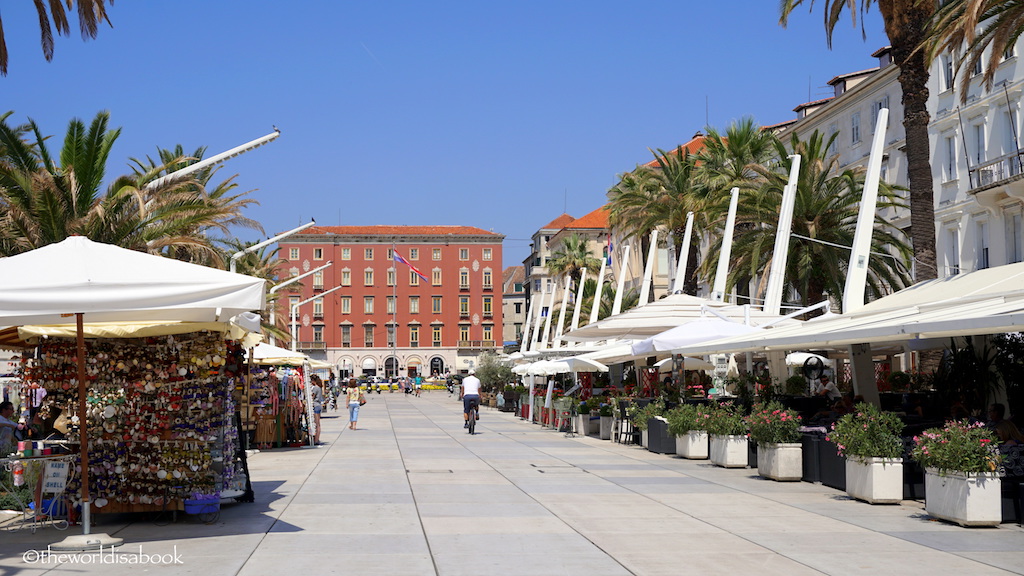
Returning to Diocletian’s Palace
After the tour and boardwalk, we went back to the ship to quickly eat lunch. But, my daughter and I went back into town to further explore Diocletian’s Palace and shop. We found some areas to be less crowded than our morning visit.
We also got to spend more time exploring some shops and souvenir stalls within the complex. There were many jewelry and clothing shops and cute cafes.
They sold lavender in many places since Croatia was one of its biggest growers. We now have a supply of Croatian lavender that will last us for awhile.
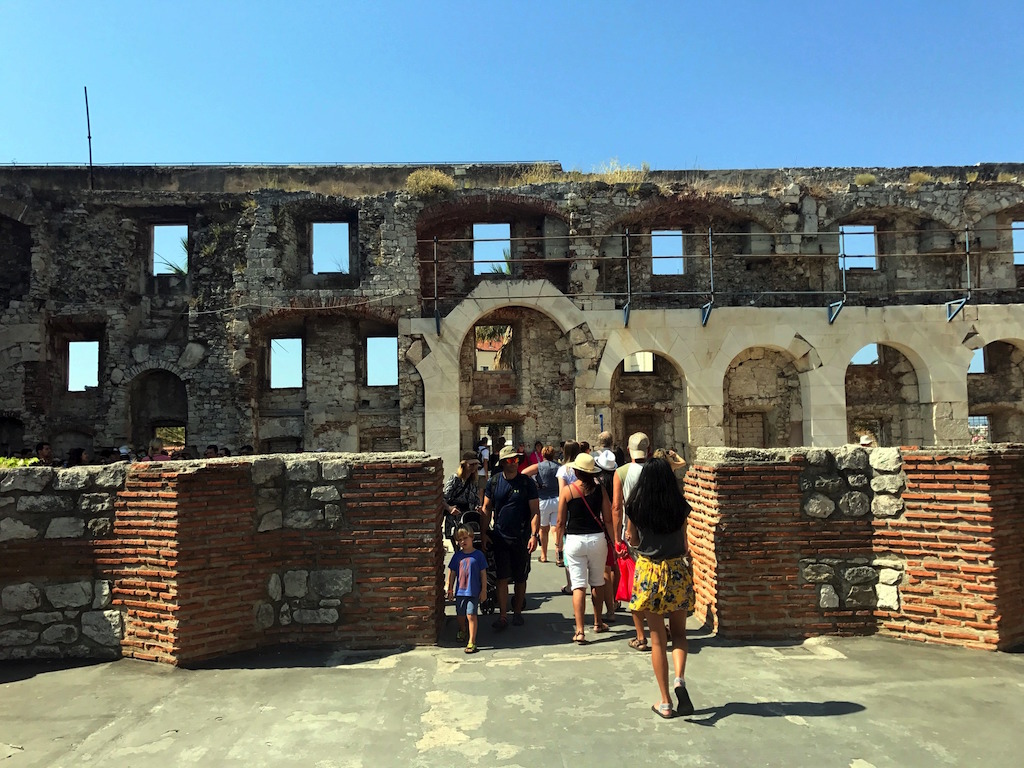
If you’re a fan of the HBO TV show, Game of Thrones, there was a whole shop with so much merchandise related to the show within the palace. The show used the palace as a filming location.
We didn’t know too much about Split before this trip. But, this city and along with the minimal time we spent in Dubrovnik made us put Croatia near the top of places to return to for an extended land trip.
Split boasted abundant history, captivating architecture, Roman ruins, sandy beaches, and locals who were friendly and welcoming. Even if you’re only here for a day, it’s easy to see the beauty and history of Split.
Tips for spending a day in Split and exploring Diocletian’s Palace
- There is no entrance fee or ticket booth into the palace. Get lost inside and explore.
- There are entrance fees to the cellars, church and bell tower. A combo ticket is available for the bell tower, Jupiter’s temple and church.
- Book a tour to explore Diocletian’s Palace . We booked our bus and walking tour with Split Sightseeing. You can book online and this was a two-hour tour.
- If you’re only here for a day as part of a cruise itinerary, we highly recommend doing this tour to get a good overview of Split and Diocletian’s Palace. There were other tours that included beach days and visits to Krka National Park.
- Bacvice Beach was about 15-20 minute walk from the Old Town. It was actually closer to the cruise terminal. We saw it from afar and had some large inflatable equipment in the water.
Pin it for later!
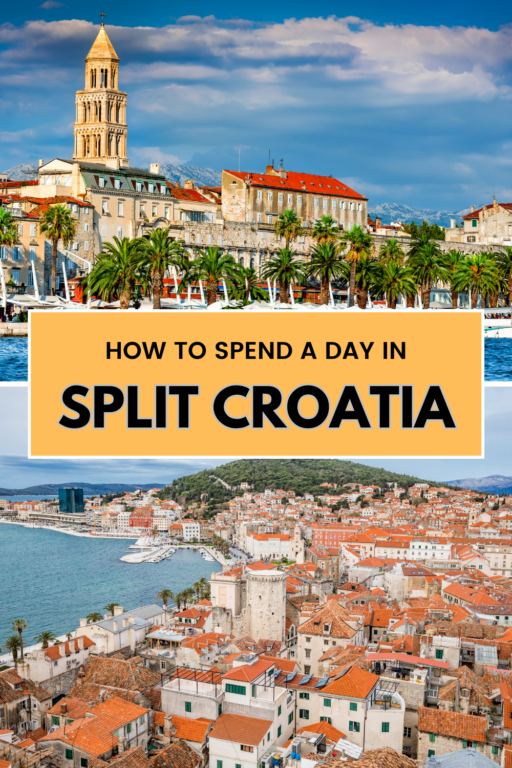
I absolutely loved Split and would go back in a heartbeat!
#TravelPhotoThursday
I’ve heard so many say that Croatia is one of their favorite countries – and especially Split. So much so that we’ve put it on our European itinerary for next year. Beautiful photos of a beautiful place.
We spent 2 weeks in Croatia this summer, loved our time there. For me, it was amazing to stay in the old palace in split. We didnt take a guided tour, just wandered around the day and saw pretty much what you have covered above.
Looks good! I can see all the different jokes that can be made taking into consideration the name. The banana split one is just so funny (have not thought of that). I agree it is better to take a tour with an independent operator. The tours offered by the ships use them anyway but charge more. Split looks like an ideal vacation spot. It is in Europe but I can pass by a Caribbean location. #TPThursday
I absolutely don’t know how I’ve lived in Europe my whole life but still never made it to Croatia! It really is a shame and your post & beautiful pictures definitely reminded me that I need to book a flight there asap! #WeekendWanderlust
I really liked Split, even though it seemed to get very busy when cruises came in or when yachts got ready to depart for the coast. Sounds like you had a really good tour guide and you seem to have covered most of the main spots in town. #TheWeeklyPostcard
One of these years I am going to do a Mediterranian cruise! I have done lots in the Caribbean. I definitely agree to book with a third party instead of the cruiseline for tours. You can save so much money. On another note – did your wish come true? Thanks for sharing on #TheWeeklyPostcard
I enjoyed a day here in early May this year on a Mediterranean cruise and loved seeing your photos of such a beautiful city. We didn’t do an organised tour of Split but we saw a lot the sights that you did. Your photos are extraordinary.
We loooved Split! I’d really love to go back and take my parents! It’s nice that you got out of Split a bit to see more whereas we focused monstly on the Palace and the beach nearby! Thanks for linking up with #TheWeeklyPostcard!
We spent 3 weeks in Croatia last year – a week of that staying in the grounds of the Palace. Prior to my visit Rome was my favourite city in Europe but it shares that now with Split. We loved it and there are some fabulous day trips you can take for longer if you decide to return for a longer stay. I highly recommend Croatia – I think it is one of the most beautiful countries in Europe. #weeklypostcard and #weekendwanderlust
You reminded me about this beautiful palace. We were there in May and I absolutely fell in love with Split. We’ve spent almost 4 days there, but I feel there was so much more to see and do in Split. It seems the city wasn’t very crowded when you visited it. #TheWeeklyPostcard
Coming from Canada where the vast majority of historical sites are less than 200 years old, it is so fascinating to read about these places that date back to the Middle Ages. Great reading about the palace complex.
Do you know one fact in common for the White House in Washington that was built in 1800, and the Palace of Emperor Diocletian in Croatian Split erected in distant 305? The origin of the stone used for the building. It was taken from the same island.